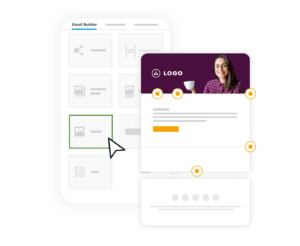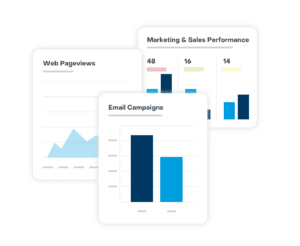What Are the Best Times to Send B2B Emails?
So you’re chasing the answer to that decades-old marketing question: When is the best time to send an email?
We get it. You want to capture your audience when they’re most attentive—right when they have the highest likelihood to convert. The thing is, the answer depends on several factors like:
- Your industry
- Your target audience’s title
- Your intent
Consumers are different from business professionals. Moms are different from college students. Executives are different from developers. That means your B2B email marketing content and send times should be too.

Since you focus primarily on B2B marketing, your emails must reach prospects and subscribers at times when they conduct business. Though the answer can vary for every sender, research reveals common trends for when your B2B audiences will respond best.
The Best Days and Times for B2B Email
In general, offices function 8:00 a.m. to 5:00 p.m. Monday through Friday. But the work-from-home revolution has skewed workers’ hours a bit. Still, research suggests that B2B emails are best sent around 10:00 a.m. Most professionals (whether early birds or later starters) are online and checking their inboxes. It’s also well before the lunch hour and the afternoon slump.
The middle ground also plays a role in the best day to send a B2B email. Email engagement is highest mid-week—after the Monday ramp up, but before the weekend distraction.
While this insight gives you a solid time to aim for across the business world, it doesn’t account for the email behaviors of the people and industries you might target. For instance:
- Investors and executives tend to check emails more frequently, so the day of the week doesn’t matter as much.
- Americans have a lower open rate than the UK, EU, or APAC, but they also have a lower unsubscribe rate.
- Unsurprisingly, the worst days to send emails are on weekends, resulting in low click-through rates.
Why Does B2B Email Send Time Matter?
Even if you use an automated email marketing platform, you probably spend significant time planning your strategy and content. When you intentionally plan your send times to coincide with audience engagement, you increase your return on investment for each email and campaign. And when you personalize your email content, it gives subscribers more reasons to click, convert and stay engaged for the next time you email them.
Most email marketing solutions have options to help you pinpoint and select the best send time for your campaigns with send now, send later, or schedule functionality considering different time zones.
How to Measure Email Marketing Performance
You’ll know your email send time strategy works when you can see your email marketing metrics results. Consistently review campaign data like:
-
Open Rate
This is the percentage of subscribers that opened your email. While a typical benchmark will vary per industry, a strong email open rate is around 17%. This indicates you have a compelling subject line that is most likely short and easy to understand. Emails with high open rates are mobile-optimized and contain engaging preheader (or preview) text.
-
Click-Through Rate
Click-through rates measure the percentage of clicks attributed to a particular link in your email. This indicates which email content is most engaging and what readers want to know more about. The average email click-through rate across all industries is about 2.62%. It is always less than the number of emails opened since not every reader will click.
-
Click-to-Open Rate
This is the ratio between the number of people who opened your email and those who clicked. The average click-to-open rate is about 14.9% across all industries, but real estate, education, and government emails boast the highest numbers, around 14%. This rate indicates which content in your emails is most important to readers.
Rates will vary across industry, audience makeup, and even your own campaigns. The key is to better understand your audience (and subsequently their needs) by segmenting into as many categories as possible—website behavior, company size, products purchased, etc.
Best Practices for Scheduling Your Emails
What’s the best time to send an email to your organization? You be the judge. Try tactics like:
1. Learn About Your Audience
Data is the key to understanding your audience’s habits and needs. Choose an email marketing solution that allows you to track and report on campaign performance so you can watch how they respond to new content. Learn more about them through social media responses, Google Analytics, or customer surveys. Collect everything you can to understand their behaviors, and adjust your campaigns accordingly.
2. Test, Test, Test
As you adjust variables (like send time), give your campaigns time to gather data—but remember, they’re not permanent. Email marketing B2B oriented takes a lot of A/B testing. A/B test send times the same way you test content. Then, take action on the email metrics you collect to see what works best. Keeping your email strategy fresh is essential, as your customers’ habits may change.

3. Monitor the Competition
You’ll never be able to view your competitors’ email performance rates, but you can always subscribe to their list to better understand what send times they think are most beneficial. Plus, you’ll see what messages they’re promoting to spark new ideas or counter their claims with your own value propositions.
How Sugar Market Helps Improve Your B2B Email Marketing Strategy
You have enough to worry about without spending precious time tediously building campaigns. Sugar Market takes care of all the behind-the-scenes work, so you can easily design emails with a drag-and-drop editor, preview and adjust details for greater conversion, and schedule emails for deployment at the most critical times. We give you a powerful BI-grade reporting module so you can regularly track performance and adjust your strategy as needed. Even if you don’t catch subscribers right as they’re cleaning out their inboxes, we help you create entire email marketing for B2B campaigns that monitor their engagement along the entire journey and gauge their buying interest through predictive AI.
Plus, Sugar Market helps you gather all your channels into one. Connect and engage with new prospects and customers through inbound and outbound emails, social media management, AI-driven predictive analytics, and even Google Ads management tools. Sugar Market is a multi-channel platform for all your marketing needs.
Start sending B2B sales and marketing emails at the right time, with the right content. Experience the power of Sugar Market by watching a 3-minute demo today.



